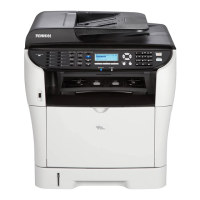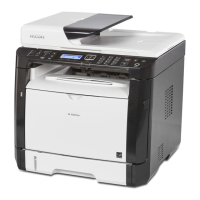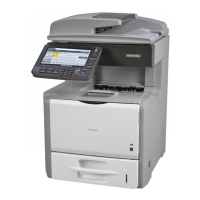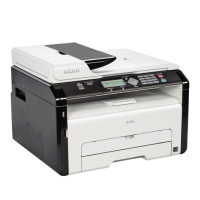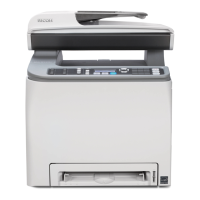Troubleshooting
298
9
❖ When other problems occur
The table below describes how to troubleshoot problems that do not produce
an error code.
Problem Solution
Cannot send faxes. See the solutions provided for errors 1XXX32 to 1XXX84 in
the above table.
Cannot receive faxes. See the solutions provided for errors 2XXX32 to 2XXX84 in
the above table.
Cannot receive faxes even when
sending them is possible.
• A print cartridge is empty. Replace the print cartridge.
See p.307 “Replacing the Print Cartridge”.
• The paper tray is empty. Load paper in the paper tray.
See p.65 “Loading Paper”.
• If fax reception mode is Manual mode, you must receive
the fax manually. See p.192 “Receiving a Fax”.
Cannot print received faxes. • The paper tray is empty. Load paper in the paper tray.
See p.65 “Loading Paper”.
• The paper tray does not contain paper of the right size.
Load paper of the right size in the paper tray.
Faxes you sent appear spotty or
dirty when received.
• The exposure glass or ADF is dirty. See p.313 “Clean-
ing”.
• Before placing originals on the exposure glass, make sure
that ink or correction fluid is dry.
A fax you sent appears blank
when received.
The original was placed upside down. Place the original in
the correct orientation. See p.84 “Placing Originals”.
The background of received im-
ages is dirty, or images from the
rear side of the originals are visi-
ble.
Image density is too high. Adjust the image density. See
p.130 “Adjusting Image Density”.
Faxes you sent come out too
light on the receiving end.
Low room temperature may have caused the machine to
scan originals unclearly. Selecting [Longer] for [Scan Warm-up
Time] under [Machine Settings] may help to improve the scan-
ning quality.
See p.218 “Machine Settings”.
Dial fails when trying to send
faxes.
See the solutions provided for errors 1XXX22 to 1XXX23 in
the above table.
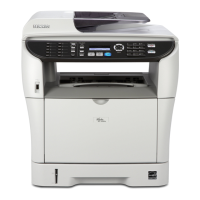
